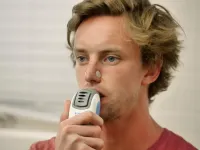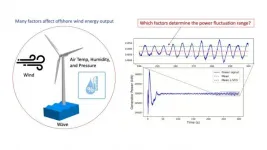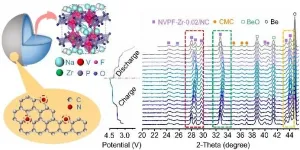INFORMATION:
The study was funded through support from the European Research Council (ERC starting grant), the Israel Science Foundation (ISF), and the Ministry of Science and Technology (MOST).
Link to the article:
https://science.sciencemag.org/content/372/6549/1462
Link to the research video:
https://www.youtube.com/watch?v=foqzblD6pvo
Introducing the world's thinnest technology -- only two atoms thick
Technological breakthrough from Tel Aviv University
2021-06-30
(Press-News.org) A scientific breakthrough: Researchers from Tel Aviv University have engineered the world's tiniest technology, with a thickness of only two atoms. According to the researchers, the new technology proposes a way for storing electric information in the thinnest unit known to science, in one of the most stable and inert materials in nature. The allowed quantum-mechanical electron tunneling through the atomically thin film may boost the information reading process much beyond current technologies.
The research was performed by scientists from the Raymond and Beverly Sackler School of Physics and Astronomy and Raymond and Beverly Sackler School of Chemistry. The group includes Maayan Vizner Stern, Yuval Waschitz, Dr. Wei Cao, Dr. Iftach Nevo, Prof. Eran Sela, Prof. Michael Urbakh, Prof. Oded Hod, and Dr. Moshe Ben Shalom. The work is now published in Science magazine.
"Our research stems from curiosity about the behavior of atoms and electrons in solid materials, which has generated many of the technologies supporting our modern way of life," says Dr. Ben Shalom. "We (and many other scientists) try to understand, predict, and even control the fascinating properties of these particles as they condense into an ordered structure that we call a crystal. At the heart of the computer, for example, lies a tiny crystalline device designed to switch between two states indicating different responses - "yes" or "no", "up" or "down" etc. Without this dichotomy - it is not possible to encode and process information. The practical challenge is to find a mechanism that would enable switching in a small, fast, and inexpensive device.
Current state-of-the-art devices consist of tiny crystals that contain only about a million atoms (about a hundred atoms in height, width, and thickness) so that a million of these devices can be squeezed about a million times into the area of one coin, with each device switching at a speed of about a million times per second.
Following the technological breakthrough, the researchers were able, for the first time, to reduce the thickness of the crystalline devices to two atoms only. Dr. Ben Shalom emphasizes that such a thin structure enables memories based on the quantum ability of electrons to hop quickly and efficiently through barriers that are just several atoms thick. Thus, it may significantly improve electronic devices in terms of speed, density, and energy consumption.
In the study, the researchers used a two-dimensional material: one-atom-thick layers of boron and nitrogen, arranged in a repetitive hexagonal structure. In their experiment, they were able to break the symmetry of this crystal by artificially assembling two such layers. "In its natural three-dimensional state, this material is made up of a large number of layers placed on top of each other, with each layer rotated 180 degrees relative to its neighbors (antiparallel configuration)" says Dr. Ben Shalom. "In the lab, we were able to artificially stack the layers in a parallel configuration with no rotation, which hypothetically places atoms of the same kind in perfect overlap despite the strong repulsive force between them (resulting from their identical charges). In actual fact, however, the crystal prefers to slide one layer slightly in relation to the other, so that only half of each layer's atoms are in perfect overlap, and those that do overlap are of opposite charges - while all others are located above or below an empty space - the center of the hexagon. In this artificial stacking configuration the layers are quite distinct from one another. For example, if in the top layer only the boron atoms overlap, in the bottom layer it's the other way around."
Dr. Ben Shalom also highlights the work of the theory team, who conducted numerous computer simulations "Together we established deep understanding of why the system's electrons arrange themselves just as we had measured in the lab. Thanks to this fundamental understanding, we expect fascinating responses in other symmetry-broken layered systems as well," he says.
Maayan Wizner Stern, the PhD student who led the study, explains: "The symmetry breaking we created in the laboratory, which does not exist in the natural crystal, forces the electric charge to reorganize itself between the layers and generate a tiny internal electrical polarization perpendicular to the layer plane. When we apply an external electric field in the opposite direction the system slides laterally to switch the polarization orientation. The switched polarization remains stable even when the external field is shut down. In this the system is similar to thick three-dimensional ferroelectric systems, which are widely used in technology today."
"The ability to force a crystalline and electronic arrangement in such a thin system, with unique polarization and inversion properties resulting from the weak Van der Waals forces between the layers, is not limited to the boron and nitrogen crystal," adds Dr. Ben Shalom. "We expect the same behaviors in many layered crystals with the right symmetry properties. The concept of interlayer sliding as an original and efficient way to control advanced electronic devices is very promising, and we have named it Slide-Tronics".
Maayan Vizner Stern concludes: "We are excited about discovering what can happen in other states we force upon nature and predict that other structures that couple additional degrees of freedom are possible. We hope that miniaturization and flipping through sliding will improve today's electronic devices, and moreover, allow other original ways of controlling information in future devices. In addition to computer devices, we expect that this technology will contribute to detectors, energy storage and conversion, interaction with light, etc. Our challenge, as we see it, is to discover more crystals with new and slippery degrees of freedom."
ELSE PRESS RELEASES FROM THIS DATE:
5-minute workout lowers blood pressure as much as exercise, drugs
2021-06-30
Working out just five minutes daily via a practice described as "strength training for your breathing muscles" lowers blood pressure and improves some measures of vascular health as well as, or even more than, aerobic exercise or medication, new CU Boulder research shows.
The study, published June 29 in the Journal of the American Heart Association, provides the strongest evidence yet that the ultra-time-efficient maneuver known as High-Resistance Inspiratory Muscle Strength Training (IMST) could play a key role in helping aging adults fend off cardiovascular disease - the nation's leading killer.
In the United States alone, 65% of adults over age 50 have ...
Employed individuals more likely to contract the flu, study shows
2021-06-30
A University of Arkansas researcher and international colleagues found that employed individuals, on average, are 35.3% more likely to be infected with the flu virus.
The findings confirm a long-held assumption about one prevalent way illness spreads and could influence government policy on public health and several issues for private companies, from optimal design and management of physical work spaces to policy decisions about sick leave and remote work.
To track influenza incidence, Dongya "Don" Koh, assistant professor of economics in the Sam M. Walton College of Business, and colleagues relied on nationally representative data from the Medical ...
College students experience significant grief reactions during global pandemic
2021-06-30
A new study shows that colleges students are experiencing significant grief reactions in response to the COVID-19 pandemic. The paper, "College Student Experiences of Grief and Loss Amid the COVID-19 Global Pandemic," was recently published in OMEGA - Journal of Death and Dying.
"This study aimed to identify the most common non-death losses and grief reactions experienced by undergraduate and graduate college students amid the pandemic," said author Erica H. Sirrine, Ph.D., director of Social Work at St. Jude Children's Research Hospital. "What we found is that students ...
Researchers create better method to predict offshore wind power
2021-06-30
New Brunswick, N.J. (June 28, 2021) - Rutgers researchers have developed a machine learning model using a physics-based simulator and real-world meteorological data to better predict offshore wind power.
The findings appear in the journal Applied Energy.
Offshore wind is rapidly maturing into a major source of renewable energy worldwide and is projected to grow by 13% in the next two decades and 15-fold by 2040 to become a $1 trillion industry, matching capital spending on gas- and coal-fired power generation. In the United States, for instance, New York and New Jersey recently awarded two offshore ...
Rattlesnakes may like climate change
2021-06-30
When it comes to climate change, not all organisms will lose out. A new Cal Poly study finds that rattlesnakes are likely to benefit from a warming climate.
A combination of factors makes a warming climate beneficial to rattlesnakes that are found in almost every part of the continental United States but are especially common in the Southwest.
Rattlers are experts at thermoregulation. Researchers found that, when given a choice, the snakes prefer a body temperature of 86-89 degrees Fahrenheit, a much warmer temperature than they generally experience in nature. The average ...
Reducing need for blood transfusion during heart surgery is focus of new practice guideline
2021-06-30
CHICAGO (June 30, 2021) -- Four leading medical specialty societies released a new clinical practice guideline today that includes recommendations for reducing blood loss during heart surgery and improving patient outcomes. The document, a multidisciplinary collaboration among The Society of Thoracic Surgeons, the Society of Cardiovascular Anesthesiologists, the American Society of ExtraCorporeal Technology, and the Society for the Advancement of Patient Blood Management, is available online in The Annals of Thoracic Surgery and two other journals.
"As medicine evolves and we learn more, it always is important to review past ...
In-situ structural evolution of Zr-doped Na3V2(PO4)2F3 coated by N-doped carbon for SIB
2021-06-30
Na3V2(PO4)2F3(NVPF), a cathode material used in sodium-ion batteries (SIB), features ultrafast Na+ migration and high structural stability because of its three-dimensional open framework. However, the poor intrinsic electronic conductivity of NVPF often leads to high polarization, low Coulombic efficiency, and unsatisfactory rate performance, which hinder its commercial application.
Recently, a group led by Prof. Shuangqiang Chen and Prof. Yong Wang from Shanghai University synthesized zirconium-doped NVPF nanoparticles coated with a nitrogen-doped ...
Breakthrough for tracking RNA with fluorescence
2021-06-30
Researchers at Chalmers University of Technology, Sweden, have succeeded in developing a method to label mRNA molecules, and thereby follow, in real time, their path through cells, using a microscope - without affecting their properties or subsequent activity. The breakthrough could be of great importance in facilitating the development of new RNA-based medicines.
RNA-based therapeutics offer a range of new opportunities to prevent, treat and potentially cure diseases. But currently, the delivery of RNA therapeutics into the cell is inefficient. For new therapeutics to fulfil ...
Slowing down grape ripening can improve berry quality for winemaking
2021-06-30
Wine grapes are particularly finicky when it comes to their environment. For instance, heatwaves and droughts lead to earlier berry ripening and lackluster wine. And these types of episodes are expected to intensify as Earth's climate changes. Now, researchers reporting in ACS' Journal of Agricultural and Food Chemistry have tweaked growing conditions for Cabernet Sauvignon grapes to slow down their ripening, which increased the levels of compounds associated with wine's characteristic floral and fruity notes.
As grapes ripen and change color from light green to deep red, sugars and aroma compounds accumulate in the berries. But, when they ripen quickly because of heat or water stress, the resulting fruits produce ...
Discovery of the role of a key gene in the development of ALS
2021-06-30
Amyotrophic lateral sclerosis, or ALS, attacks nerve cells known as motor neurons in the brain and spinal cord, gradually leading to paralysis. The loss of function of an important gene, C9orf72, may affect communication between motor neurons and muscles in people with this disease. These findings were revealed by the team of Dr Kessen Patten of the Institut national de la recherche scientifique (INRS) in the prestigious journal Communications Biology.
A mutation in the C9orf72 gene is the primary genetic cause of ALS. The mutation in C9orf72 consists of an expansion of a sequence of six DNA bases (GGGGCC) that is very unusual, going from a few copies (less than 20 in a healthy person) to more than 1000 copies. The mutation, in part resulting in a loss of function, ...
LAST 30 PRESS RELEASES:
Tracing the quick synthesis of an industrially important catalyst
New software sheds light on cancer’s hidden genetic networks
UT Health San Antonio awarded $3 million in CPRIT grants to bolster cancer research and prevention efforts in South Texas
Third symposium spotlights global challenge of new contaminants in China’s fight against pollution
From straw to soil harmony: International team reveals how biochar supercharges carbon-smart farming
Myeloma: How AI is redrawing the map of cancer care
Manhattan E. Charurat, Ph.D., MHS invested as the Homer and Martha Gudelsky Distinguished Professor in Medicine at the University of Maryland School of Medicine
Insilico Medicine’s Pharma.AI Q4 Winter Launch Recap: Revolutionizing drug discovery with cutting-edge AI innovations, accelerating the path to pharmaceutical superintelligence
Nanoplastics have diet-dependent impacts on digestive system health
Brain neuron death occurs throughout life and increases with age, a natural human protein drug may halt neuron death in Alzheimer’s disease
SPIE and CLP announce the recipients of the 2025 Advanced Photonics Young Innovator Award
Lessons from the Caldor Fire’s Christmas Valley ‘Miracle’
Ant societies rose by trading individual protection for collective power
Research reveals how ancient viral DNA shapes early embryonic development
A molecular gatekeeper that controls protein synthesis
New ‘cloaking device’ concept to shield sensitive tech from magnetic fields
Researchers show impact of mountain building and climate change on alpine biodiversity
Study models the transition from Neanderthals to modern humans in Europe
University of Phoenix College of Doctoral Studies releases white paper on AI-driven skilling to reduce burnout and restore worker autonomy
AIs fail at the game of visual “telephone”
The levers for a sustainable food system
Potential changes in US homelessness by ending federal support for housing first programs
Vulnerability of large language models to prompt injection when providing medical advice
Researchers develop new system for high-energy-density, long-life, multi-electron transfer bromine-based flow batteries
Ending federal support for housing first programs could increase U.S. homelessness by 5% in one year, new JAMA study finds
New research uncovers molecular ‘safety switch’ shielding cancers from immune attack
Bacteria resisting viral infection can still sink carbon to ocean floor
Younger biological age may increase depression risk in older women during COVID-19
Bharat Innovates 2026 National Basecamp Showcases India’s Most Promising Deep-Tech Ventures
Here’s what determines whether your income level rises or falls
[Press-News.org] Introducing the world's thinnest technology -- only two atoms thickTechnological breakthrough from Tel Aviv University





